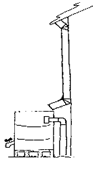Catch the rain...that would have washed away!
Storm water Facts
Your rain barrel will help slow runoff and encourage infiltration.
- Rooftops are impervious surfaces, along with roads, parking lots, driveways and even compacted soils
- In a pristine area, even an additional 10 percent of impervious area alters the natural rainfall runoff cycle and has the potential to damage sensitive ecosystems
- Infiltration, allowing the water to soak into nearby soils, will recharge groundwater supplies and return the water cycle to a more natural path
Water Conservation Facts
Your rain barrel will help conserve water.
Water usage in the Metro-Atlanta area increases in the summer due to the increase in outdoor water usage for watering lawns, flower and vegetable beds, as well as for car washing.
By reducing your demand from established water supplies during the dry summer months you are helping the environment and conserving water.
How effective is a rain barrel?
The annual average rainfall can vary from area to area and is decreased in times of severe drought.
| Average Annual Rainfall (typical year) | |
|---|---|
| Georgia | 50.2" |
Q. How much water is shed from the average-sized (1,200 sq. ft.) roof in 1 year?
A. It varies between 25,000 - 35,000 gallons.
Q. How much rainfall is needed to fill a typical 55-gallon rain barrel?
A. The typical home has a roof area of 1,200 sq. ft. and four downspouts, each collecting from an area of 300 sq. ft. A rainfall of only 0.3 inches will fill the rain barrel.
Q. If I place a 55-gallon rain barrel at the bottom of each of 4 downspouts of my 1200 sq. ft. roof, how many times will they fill up?
A. From May 1 to September 30 each barrel could potentially fill up about 15 times.
IMPORTANT: Do not use rain barrels for drinking, cooking, watering edible plants, or bathing. If moss killer has been used on the roof, let a few rain events bypass the barrel before collecting water.
Managing Your Rain Barrel
Connecting your rain barrel to the downspout:
Cut off your downspout using a hacksaw just above the top of the rain barrel. Secure the downspout to the house with a downspout strap and sheet metal screws. Reattach the elbow to the bottom of the downspout. Place the rain barrel below the elbow so the water flows into the screened vent.
 |
 |
 |
Waterwise gardening with the rain barrel:
Water shrubs, trees, lawns, annuals and perennials with rain barrel water and mulch heavily to retain moisture during the summer months.
Increase your capacity of rainwater storage:
|
Connect a drip hose to your rain barrel and snake the hose through flower beds. Raise your barrel off the ground by placing them on cement or wooden blocks to ease access to the faucet and increase water pressure in the barrel.
Manage heavy rains:
It is essential to consider the impact of heavy winter rains on your drainage system. An overfull rain barrel has the potential to erode your home's foundation. In all cases your rain barrel should have a drain/plug near the bottom of your barrel.
Management ideas include:
- Connect a hose to the spigot and direct this away from your foundation, a minimum of 2 feet for a crawlspace, and 6 feet for basements
- Disconnect the rain barrel from the downspout and return the system to its original configuration
- Design an overflow system to encourage infiltration of the water from the barrel to the ground
For instructions on how to make your own rain barrel, please click refer to the Keep DeKalb Beautiful Rain Barrel Project - "How To" Fact Sheet and Materials Sheet.
 1300 Commerce Drive Decatur, GA 30030
1300 Commerce Drive Decatur, GA 30030
